Bhutan was always a when, and never an if. And our program management now is such that we are fairly clear of the when-where for the next 3 years, assuming life doesn’t throw tantrums. We also realised that what gets lost in us planning everything down to the last detail are the aha moments. So now, we figure out the broad things to do and let tour operators do the rest. This also ensures that there’s just the right amount of time to relax, and actually vacation! Have to wonder if age is catching up! Anyway
Part 1: Thimphu via Kolkata
My last trip to Kolkata had been 18 years ago. Our only interactions after that have been restricted to the airport, which is probably my least favourite among all that I have visited. But Kolkata I have had a fascination for. I have admired the way in which its populace has held on to traditions, and I have loved the history it contains. I don’t think any other city has these many functional Ambassadors!
Based on suggestions from our friend P, we had decided to dine at Aaheli, and chose to stay at Kenilworth. Small, but elegant and functionally adequate rooms, and very courteous staff.

We had reserved a table at Aaheli since it was a Saturday night. The Uber driver who took us to Aaheli treated his maps as some abomination, but we at least managed to reach the place, though 10 mins late. The restaurant was empty and we played the sole audience to the live music – a middle aged lady on vocals, with strings attached. Accompaniments, that is.
We ordered two Raj Bhoj thalis. Pretty soon, the restaurant was full, and so were we! Almost everything was delicious, including the vegetarian dishes, and though (as D noted) we paid more than we have probably ever paid in a restaurant in India, we enjoyed the meal thoroughly.

Our flight to Paro (Druk Air) was at 9.10, and though we didn’t really acknowledge it, it was an international flight and we had to check in a couple of hours prior. The Kenilworth folks were nice enough to pack us a breakfast before their scheduled time, and we found an Uber to take us to the airport. This Kolkata visit gave me many insights. Every city has its unsavoury side. D said she felt very uncomfortable during the small walk we took in the market area – from where the cab dropped us, to Aaheli. P had told me very clearly that we should avoid walking outside, exactly because of this. Closer to Kenilworth, I saw a part of the city that could easily have been Bangalore. And yet, when I looked closely, I could see the difference – the crowds were of all kinds. A younger me would have hardly noticed. It reminded me again of the sheltered life. Privilege.
The flight was on time, and in just over an hour and a half, we were in Bhutan. Paro airport reminded me a bit of Cambodia. It belonged to the land, unlike the sterile edifices that are common across the globe. We first checked the Duty Free shop to enquire whether they stored local liquor, specifically peach wine, because that was something we wanted to take back. They didn’t, and at that point, we didn’t know that the Duty Free would play quite a role in our return journey.
Our itinerary was in the hands of Heavenly Bhutan. We were met at the airport by the enthusiastic Sonam (THE most common name in Bhutan) and our driver for the trip Pasang.
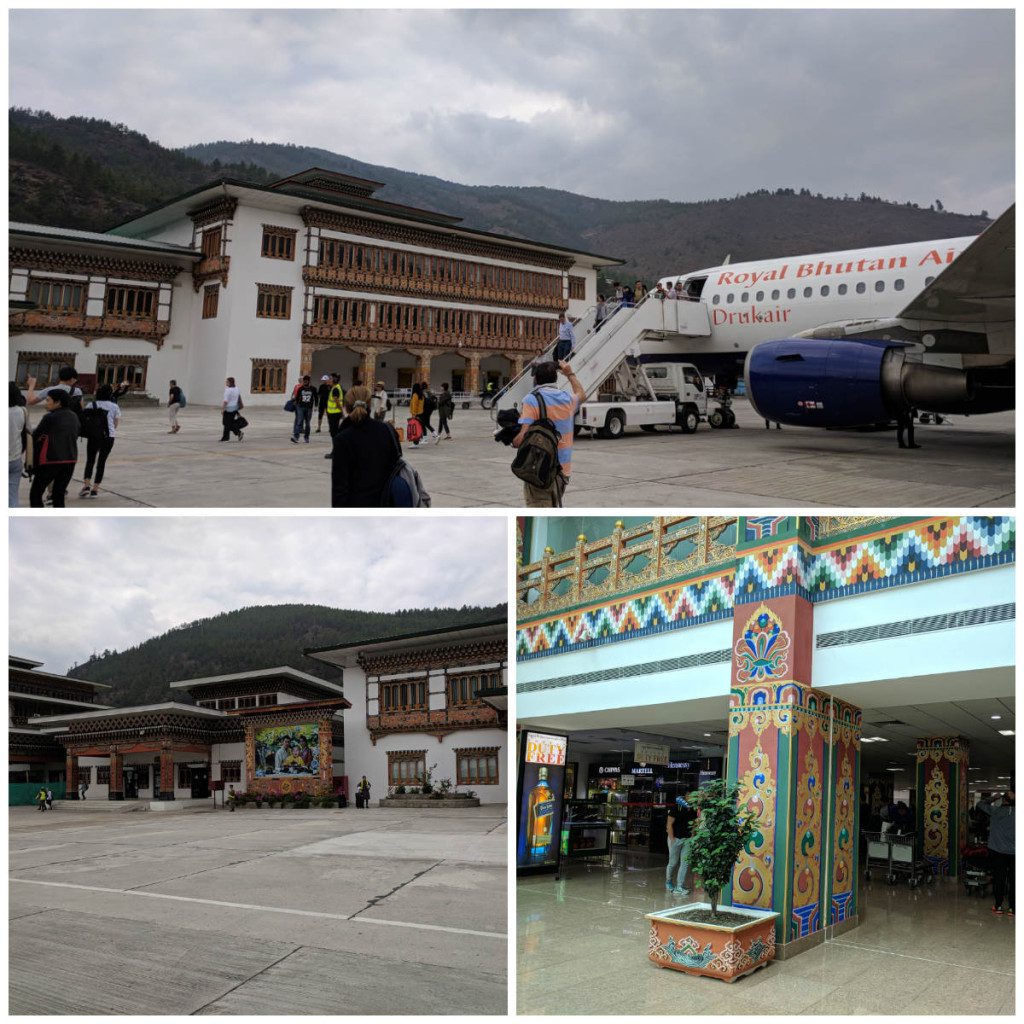
We immediately set out for Thimphu, a journey of around 45 minutes through wonderful landscapes. Sonam explained how the name Bhutan is as ‘meaningless’ as India. The name apparently was a combination of what it was called by Chinese, Indians and the British. Druk on the other hand is what the people call their land, and it means ‘thunder dragon’.
We only stopped once at Chuzom to see the confluence of the two rivers of Thimphu (Wong Chu) and Paro (Pa Chu). D claimed to have shot my photo as I crossed the river, but then showed me what she had really shot – an Assam macaque, the most common monkey in these parts. Cosmic revenge arrived promptly in the form of a cow which almost pushed her over as she was taking a photo.
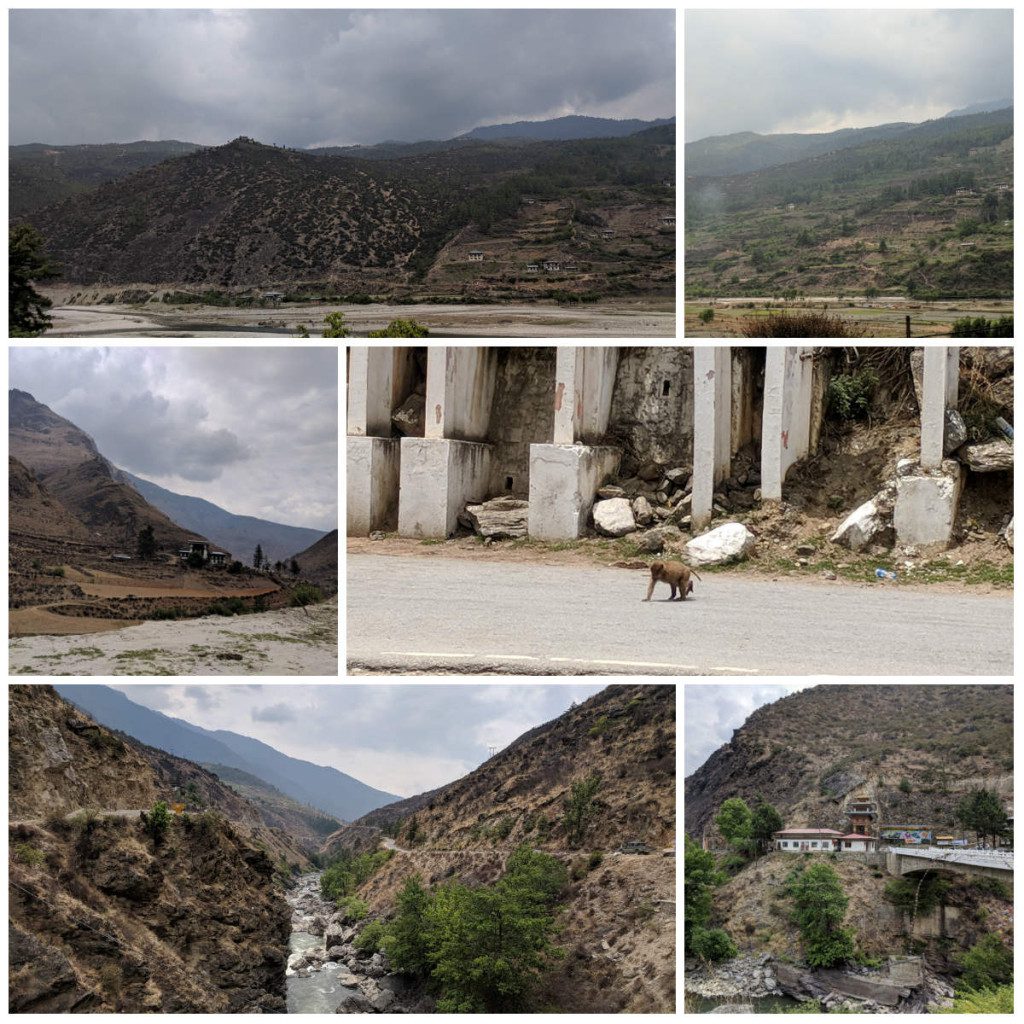
Our stay at Thimphu was at Osel, thanks to T’s recommendation. Osel is only a walk away shopping/eating/gawking areas. It seems reasonably new, and the best part is the view! On both days we spent in Thimphu, we spent a considerable amount of time during the late evening just sitting there watching the sun go down and the lights come up. A thoroughly enjoyable experience which I wish I could do more of!
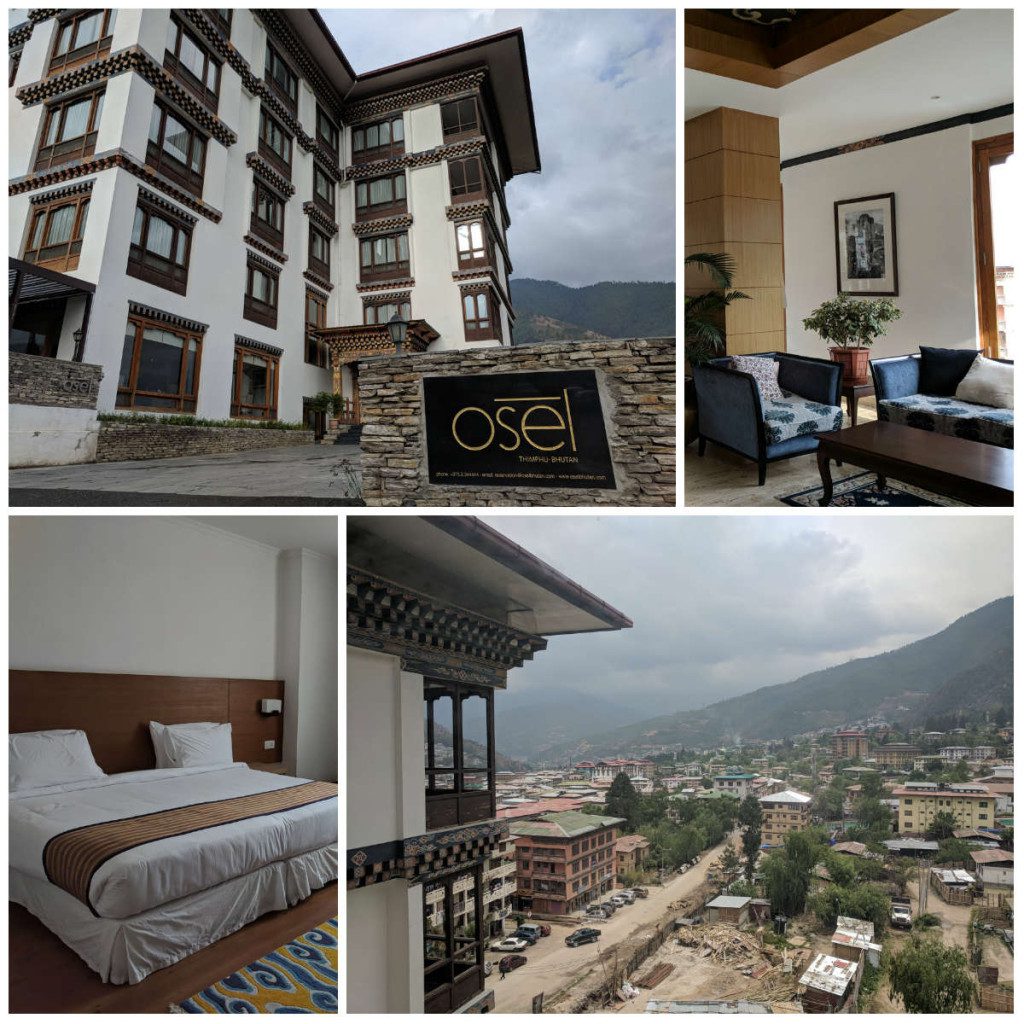
We were right on time for lunch. From our long list of restaurants we wanted to visit, we finally chose Zombala 2 (there are two, and 1 was closed on Sundays) This is close to the Clock Tower Square, right at the traffic junction, where a policeman in a nifty uniform guides traffic in a good, old fashioned manual way! Our timing couldn’t have been better, because the place started filling up as soon as we started eating! From our other long list- of things to eat – we order an Ema Datshi, a Shakam Ema Datshi, and chilly pork! The first is the national dish of Bhutan, made of cheese and chillies. The second is first + beef. From all the literature on the subject, we had expected a spice bomb, but this was quite easy to handle. I don’t know whether it’s the training from the North East pickles we keep having, or because they had made the dishes tourist friendly. We chose a bottle of Zumzin peach wine to wash it down with, and immediately fell in love. It also makes up a little for the Bhutanese not having a thing for desserts at all!
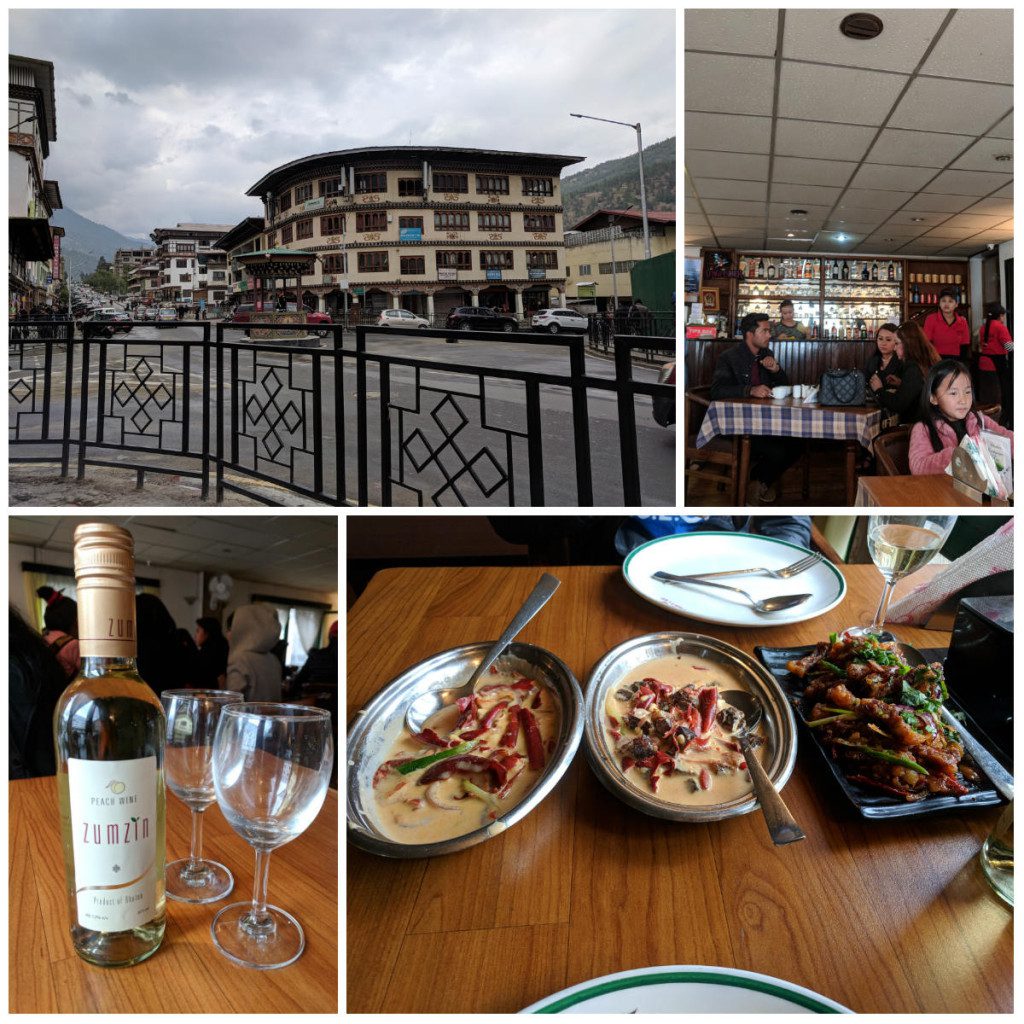
After lunch, we watched an archery competition happening nearby. Traditional bow, and a distance of 145 m. We couldn’t see the arrow after it had been released and wondered how people standing near the target managed not to get hurt! In the 20 minutes we spent there, two people managed to hit the target. Each time that happened, there was a celebration dance. We then visited the Motithang Takin Preserve. The Takin is Bhutan’s national animal, and was snooty enough to stay away from where we could see it clearly. We did see a few kinds of deer up close though. I had asked Sonam about yak meat, but he said it was rare. The meat was sold only when a yak died of natural causes. D forbade me from asking about Takin meat!
The last item on the day’s list was the Centenary Farmers Market, a weekend affair. Most of the stuff actually came from India but there was a separate floor for local products. I saw some coloured bottles from afar and got excited, but that turned out to be honey! Sonam had warned us that it would be very crowded, but then he didn’t really know what we meant by crowds in India! This one was par for the course. D did some minor shopping here before we went back to the hotel. Thimphu is fairly small and distance between places is usually 5-10 minutes of driving!
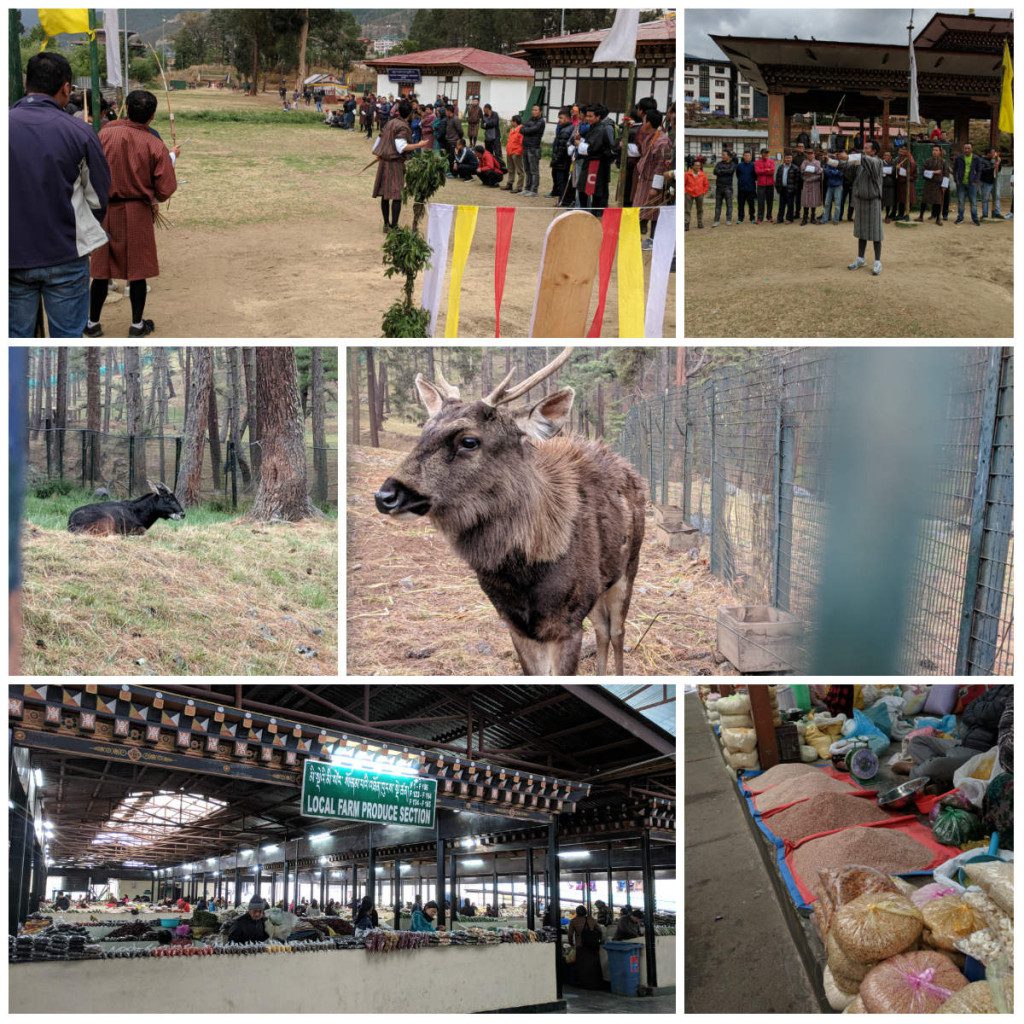
Dinner was at Osel, and this (the food) is probably the only thing that is sub par here. We tried one of the local beers – Red Panda. It’s Hefeweizen style beer, and reasonably ok. The bottling was all Kingfisher though. Recycled? After dinner, we sat in our cosy room (heater on, because the temperature was inching towards 10°C) and watched the sky turn dark. The view included a giant Buddha far away, an epitome of peace.

After a standard breakfast at Osel (only the porridge was local) we drove around the National Memorial Chorten, built in the memory of the third king, pausing only for a quick photograph. We then drove to Kuensel Phodrang – home of one of the largest Buddhas in the world. The drive itself – around 20 minutes – was lovely with fantastic vistas, as we wound up the hill. The ambition for the place is huge – plans for some 125000 mini Buddha statues, a huge area for community events, and such. The crowds were sparse when we visited, and I wondered if the cost (around 100 mn USD) incurred would provide the value. With unemployment rising in Bhutan, would this really increase gross national happiness? I looked up and saw the Buddha watching me sternly. Ok, fine!

On the way back to town, we stopped for photographs – we could see all of Thimphu from this height. The next destination was Changangkha Lhakhang, the oldest temple in Thimphu, established in the 12th century. A good place to note that wearing jackets serves two purposes – helps you keep warm, and fulfills the full sleeves attire criterion that most religious places in Bhutan have. Meanwhile, we learned of the Torma, dough and butter sculptures that serve as offering. The ‘veg’ versions are white-yellow and the others are multi coloured! The priest inside the sanctum sanctorum seemed busy with a mobile, even as renovation work continued around him.
We also visited the Thangthong Dewachen nunnery. A really old woman was spinning the prayer wheel, and Sonam explained how old people sometimes spend the day here when their children and grand children are away at work/school. Next up was the Sangaygang View Point. Among other things, you can see the legislative buildings and the king’s residence from here, and we were surprised at how (relatively) small the latter is. For someone whose family photo is plastered all over the nation, this seemed a pretty down to earth abode!
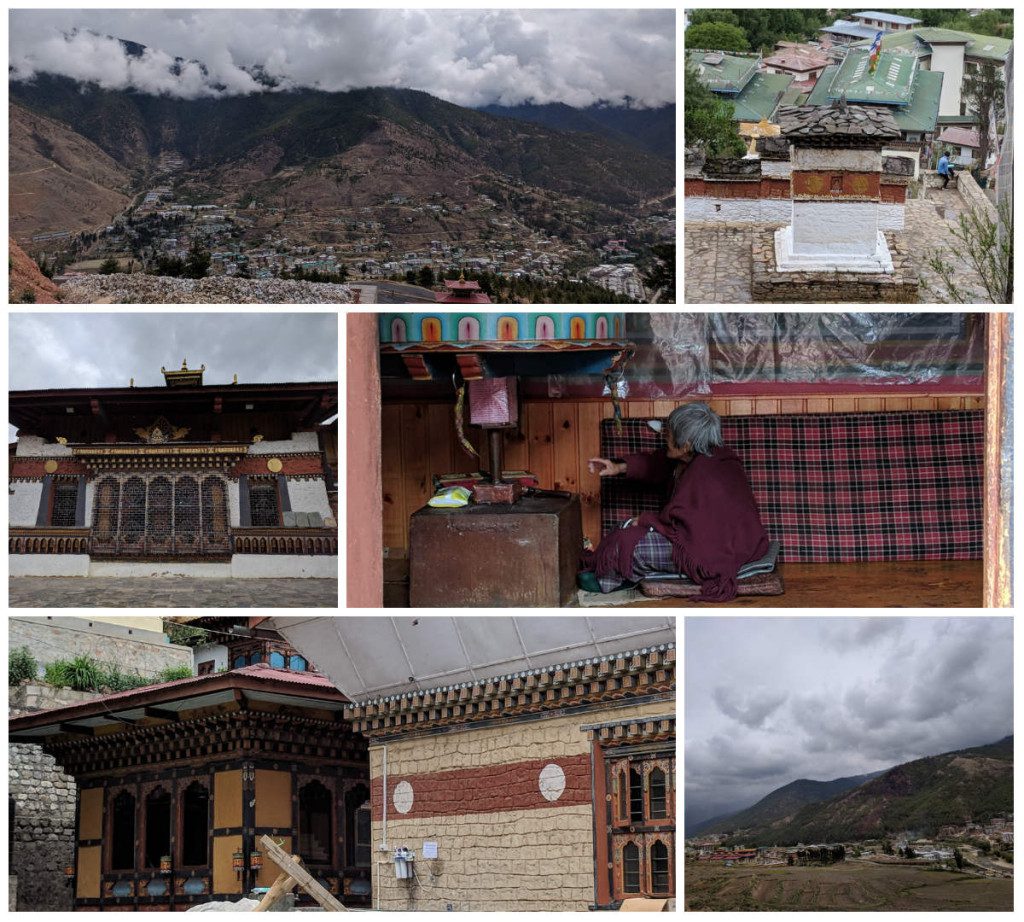
By this time, we had completed almost everything on the itinerary, but Sonam volunteered more of Thimphu to see. The National Library was an excellent experience – a really old map of India in which we tried to locate places (and names) and the book that entered the Guinness World Records as the largest published book in the world – Bhutan: A Visual Odyssey Across the Last Himalayan Kingdom – were the highlights. We then visited the Folk Heritage Museum, where we saw various artifacts and objects that have a place in everything from Bhutan’s culture to daily household chores. We also got to taste Ara. (That’s Sonam serving us Ara in the pic) Arrack all over the world tastes roughly the same. The place also has a restaurant we wanted to visit and Sonam made a dinner reservation for us.
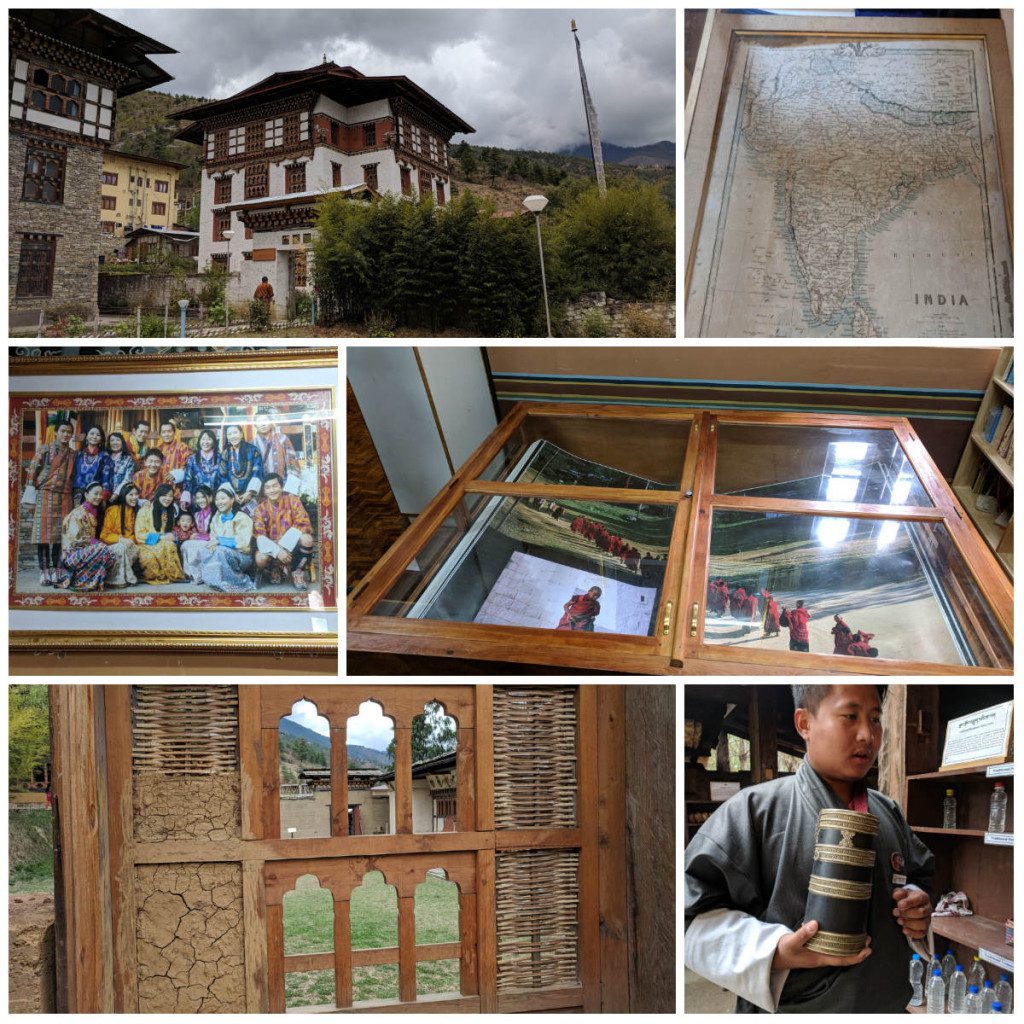
Lunch was at Yang, which offered a lovely view and got us our first taste of Suja – butter tea. We finally met Menuka from Heavenly Bhutan, who had done the tour planning for us. I quizzed her a bit to find out how the life of a working professional in Bhutan goes. Bhutan’s cinemas only show Bhutanese movies, and cable TV is a mix of local, Indian and international channels. From what we saw, beyond some snooker and karaoke joints, there are very few entertainment options out of home. I was still wondering about the happiness quotient, and how it could be sustained in the era of internet. Aren’t there just too many stimuli, and thus desires and expectations? We visited an art gallery after lunch and really liked a painting there. But we chickened out at the 7k price tag. Our later experiences showed that we should have just bargained!
We were then left to shop at the Crafts Bazaar, which (from behind) I had assumed as the parking lot of Taj Tashi! D shopped a bit, but we weren’t really kicked. Menuka had told us that Paro had some shopping options, so we decided to hold on. In any case, it had started raining. This was very near to Osel, so we walked back. The cafe at the hotel had hot chocolate and waffles – the setting was perfect!
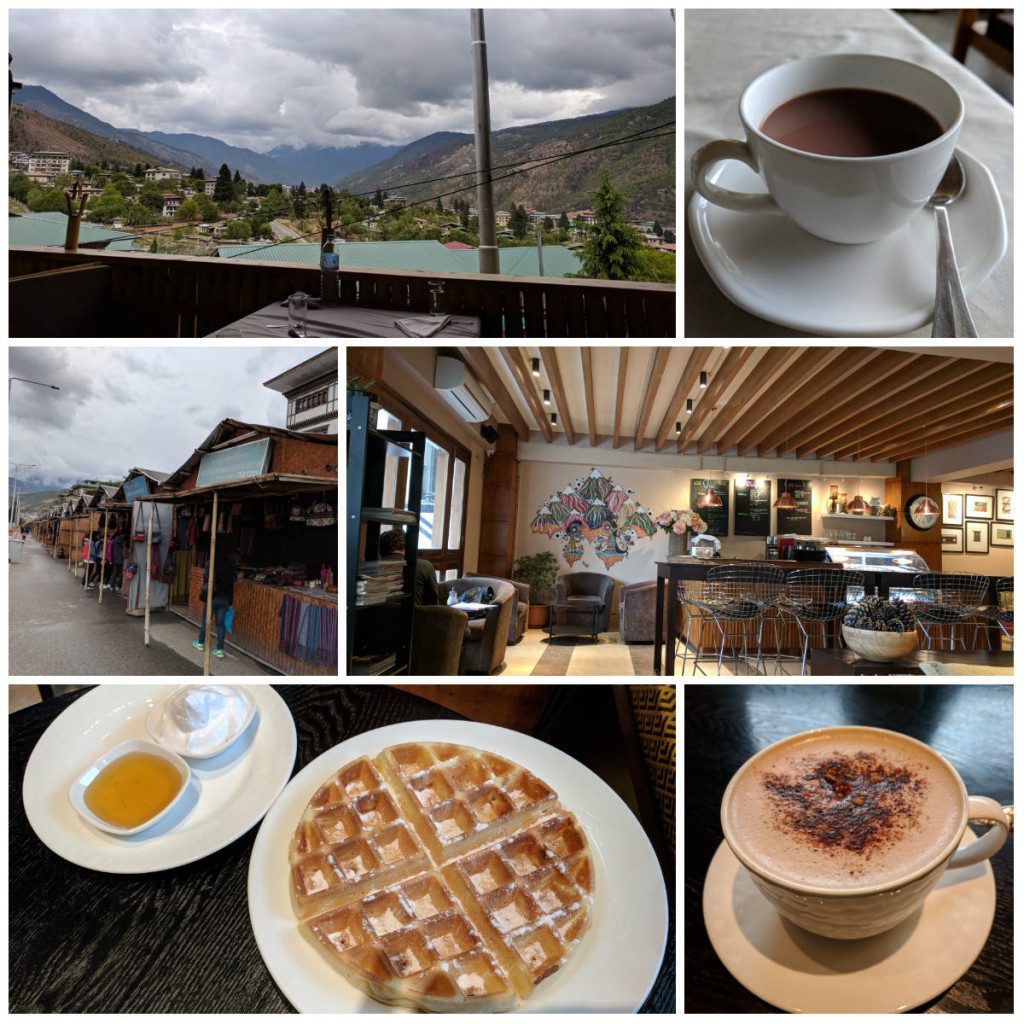
Sonam picked us up for dinner at the Folk Heritage restaurant. It was a set meal, and the new things we got to taste were Khur Le (pancake made from buckwheat) which we really liked and Sikam Paa (a bit like bacon) which was underwhelming. The vegetarian fare was good too – bitter gourd and a spinach-like preparation.
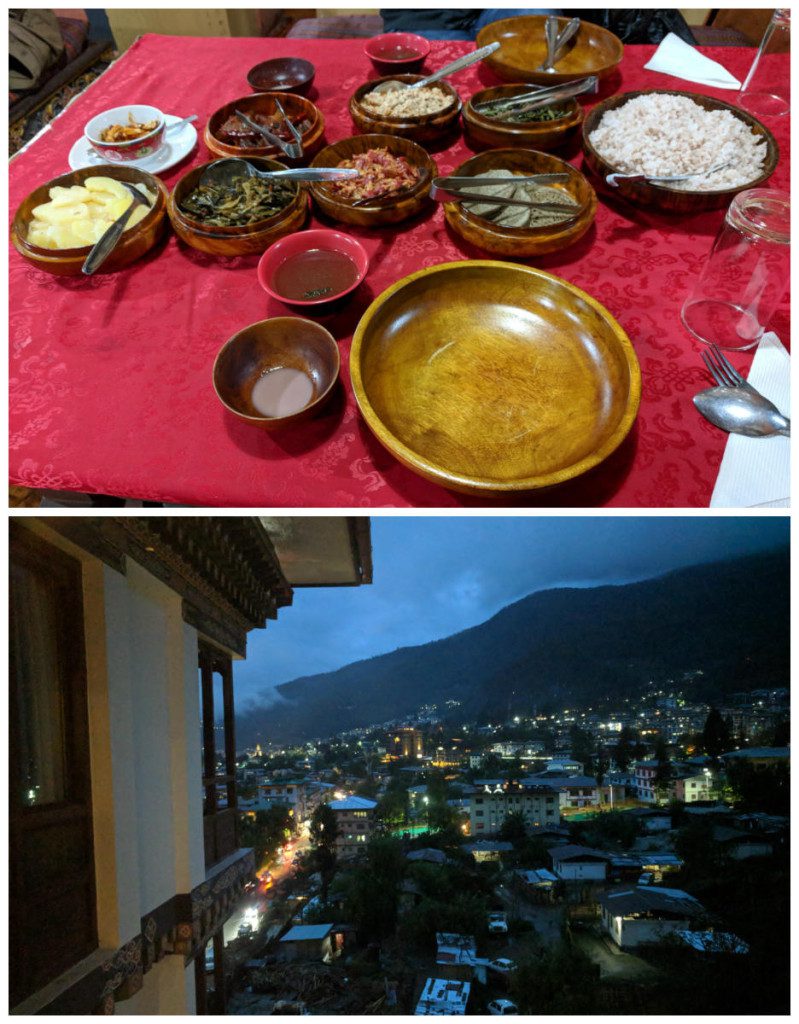
We were back at the hotel by around 8 and once again, spent lazy hours watching Thimphu by night.
Next stop: Punakha

Leave a Reply